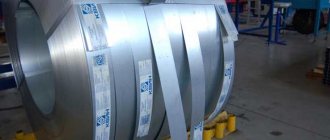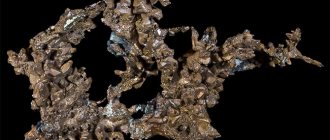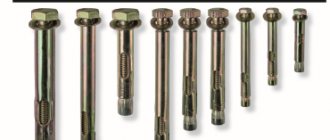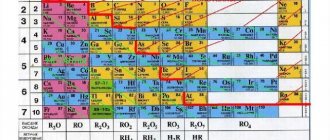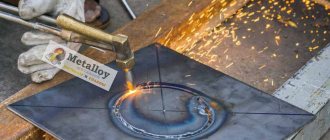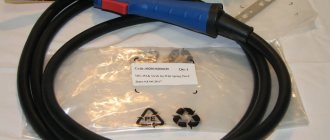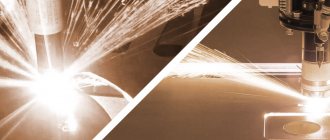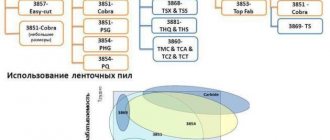Metal cutting is the process of dividing a metal sheet or pipe into several parts using manual, mechanical, or thermal methods. The Cherepovets Metal Structures Plant uses this process in the production of various products, thanks to which specialists can explain all the features in detail. The answer to the question of how to cut metal, in the conditions of modern development of industrial technologies, turns out to be quite multifaceted. Since metal is also cut for household and repair purposes, the question turns out to be relevant for many people.
Cutting methods
There are several ways to separate material. The technology depends on the equipment used in the work process. The following types of metal cutting are distinguished:
- manual;
- waterjet;
- thermal.
Manual metal cutting
Manual cutting of metal is not highly efficient and is not used on an industrial scale. The following tools are used for manual cutting:
- scissors;
- hacksaw;
- jigsaw;
- Bulgarian.
Waterjet cutting of metal
The waterjet cutting method is based on the impact of a jet of water mixed with abrasive particles on the workpiece. The pressure of the supplied liquid is 5000 atm. The advantage of this type of metal cutting is the ability to obtain a variety of lines. Alloys of a certain grade with a small sheet thickness are processed.
Thermal cutting of metal
Hot cutting of metals is based on the absence of contact between the tool and the workpiece. The hot jet melts and separates the material in the right place.
Types of thermal cutting include:
- oxygen gas;
- laser;
- plasma.
Oxygen gas cutting
Oxy-fuel cutting consists of 2 stages:
- A jet of flame is directed to the cutting site, which comes out of the cutter. Acetylene is used as a flammable material.
- After heating, oxygen is supplied, which cuts through the softened metal surface. At the same time, oxides are removed.
During operation, the distance from the bottom point of the cutter to the surface of the product must remain constant. The quality of the cut depends on this.
Laser cutters are used for this purpose. The process is based on delivering a laser beam to a point on the surface. Thermal energy is focused. The area is heated, the material melts and then evaporates. As the beam moves, it cuts the surface.
The disadvantages of this method include the ability to work with products of low thermal conductivity and small thickness.
Laser cutting of metal
Plasma
A plasmatron is used as equipment for plasma cutting. Oxygen comes out through the nozzle in it under high pressure. Its temperature is up to 20 thousand degrees. Beam width 3 mm. The surface area is heated, partially burns out, and the melt is blown out.
The advantages of the method include high cutting speed and the ability to work with workpieces up to 150 mm thick.
Mechanical metal cutting
Mechanical cutting of metal is carried out using special steel with a high degree of hardening. Due to its high hardness, the tool cuts the product.
The following types of equipment are used for cutting:
- band-saw;
- guillotine;
- disk machine.
Band saw cutting
A band saw is a blade that is fixed in special equipment. The material of the tool is the same as that of a hand-made product. There are teeth on one side. During operation of the machine engine, the pulleys rotate, due to which the belt moves continuously.
During operation there is a slight waste, because the width of the blade is 1.5 mm. It is possible to cut both sheet metal and round workpieces.
Impact cutting of metal on a guillotine
Guillotine metal cutting is used to prepare sheet steel blanks for stamping operations. The fabric to be cut is placed on a horizontal surface, fed all the way and cut with guillotine shears across the entire width in one blow.
It is important that the knives do not touch the sheet along the entire length of the surface. The upper tool is positioned at an angle. Contact with the metal occurs at 1 point, which moves along the entire length of the cut. The process resembles the work of ordinary scissors.
Cutting on a disc machine
A disk is used as a working tool. There are teeth along its outer surface. There is a protective casing on top. An electric motor is used as a drive, which rotates the disk. The result is a high quality cut.
Pipe cutters are used to cut pipes using the same principle. During the work process, the workpiece is constantly rotated 360 degrees. It is possible to make cuts at different angles.
This is interesting: Lapping and finishing - precise fitting of critical parts
Briefly about industrial types of metal cutting
Today, technologies are most often used that are characterized by high speed of production of parts and the highest accuracy of work. Large metalworking enterprises use the following types of cutting:
- gas;
- plasma;
- laser;
- waterjet;
- mechanical.
We recommend articles on metalworking
- Steel grades: classification and interpretation
- Aluminum grades and areas of their application
- Defects in metal products: causes and search methods
Gas metal cutting
- this is the effect on the material of a jet of oxygen-propane mixture, the temperature of which is much higher than the melting point of the metal. This type of cutting is similar to electrode cutting and is characterized by low cutting accuracy. The operation can be performed in various conditions without the use of complex equipment, unlike welding, which requires an electrical network.
Plasma cutting
is produced by exposing a metal sheet to a plasma jet at a temperature of +5000 to +30,000 °C. The jet is accelerated by an electric field to a speed of about 1500 m/s, which is enough to cut a metal sheet up to 20 cm thick. As a result of exposure to hot plasma, a fairly even and smooth cut is obtained that does not require further processing.
Today, this type of metal cutting is one of the fastest and most accurate. The material around the cutting area does not overheat, its structure does not change. This method is used mainly to process dielectrics and sheets of electrically conductive metals of varying degrees of hardness.
Laser cutting
The accuracy is comparable to plasma. Instead of plasma, a laser beam is used here to melt the metal sheet in the cutting area. Thanks to high-precision focusing and high power of the laser beam, the metal not only melts, but also instantly evaporates, leaving the cut line clean and smooth. When processing sheets with a thickness of more than 15 mm, additional blowing of the cutting line with inert gas or cooling with water is required. Laser cutting is usually used to produce parts of complex shapes from sheets of relatively small thickness (up to 20 mm). Steel and its alloys and various non-ferrous metals are used as blanks. The main advantage of laser processing is its ability to process very thin and fragile types of materials.
Waterjet cutting
differs from other methods in that it affects the material mechanically and not thermally. The working body here is a mixture of water and an abrasive substance, which is supplied under ultra-high pressure. The cutting width with this method ranges from 0.5 to 1.5 mm.
For this method, you can use metal sheets up to 30 cm thick. It is typical that the temperature in the cutting zone does not exceed +90 °C. Therefore, structural changes in the metal in this zone associated with exposure to high temperatures are completely excluded. There are also no fumes or emissions harmful to humans.
This type of processing using CNC machines allows you to cut bundles of several sheets and thereby increase productivity many times over. A serious disadvantage of this method is the susceptibility of the metal workpiece to corrosion.
Metal processing by cold and hot methods
Metal cutting is carried out using cold (mechanical) and hot methods. The first is characterized by a mechanical effect on the product being processed. The hardness of the cutting tool matters. Cutting is carried out with a tool that is significantly superior in hardness to the workpiece. This method uses the following tools:
- a circular saw;
- Bulgarian;
- guillotine;
- band saw machine.
Hot cutting of parts involves thermal exposure to them. They melt in the right place, and the remaining melt is removed with gas. Hot cutting includes types of cutting:
- oxygen gas;
- laser;
- plasma.
Cold metal working does not always achieve the required cleanliness of the final product. This problem occurs with oxygen and air-arc cutting. These methods are used only as preparatory work.
Air arc cutting schemes
Thermal cutting as a type of processing
Thermal cutting of rolled products is a type of metalworking that involves dividing a workpiece (removing part of the material - surface gouging) into parts by melting along a given path (line) of separation.
Thermal cutting, in addition to directly dividing the workpiece into separate parts, is also used for cutting the workpiece, combined with manipulations to prepare the edges of the part for welding or cutting, as well as for creating holes and placing reinforcement, and performing other necessary and possible actions. The following types of thermal cutting are distinguished:
- oxygen (gas) – based on the use of the properties of metal oxidation with an oxygen stream after heating the workpiece area with burning flammable gases (acetylene, propane-butane mixture, methane), mainly used when working with carbon steels;
- oxygen-flux - based on the supply and combustion of a powder reagent at a local area of the workpiece, experiencing a directed thermal effect, mainly used when working with stainless steels and thick metal sheets;
- plasma (plasma-arc) – based on the use of electrical energy to heat a directed stream of combustible gas to a temperature of 4000-5000 C0, can be used with all metals and alloys, regardless of shape;
- arc and air-arc, which are based on the use of electrical energy to melt a local area of the workpiece.
Surface gouging, performed by the air-arc method, is the most productive and effective processing method, which is based on the melting of metal under the influence of high temperature generated by an electrode on a local area of the workpiece surface. This method is often used to remove defective joints, cut holes, remove sticks (staples or strips), cut through weld roots and weld joints.
Oxygen cutting conditions
Basic conditions for oxygen cutting:
- the melting point is higher than the ignition temperature of the material in oxygen (the metal must burn in a solid state, then the cut will be even, its surface will be smooth, combustion products can be easily removed by a stream of oxygen);
- the melting temperature of slag is lower than the combustion temperature of the metal (liquid slag is easily removed from the cut);
- the heat generated must be sufficient to maintain combustion;
- the level of thermal conductivity of the metal should not be high (the incoming heat from the place where the material is cut is removed, which interferes with the cutting process);
- oxides arising during cutting should not be too viscous (for example, the presence of chromium and silicon in the metal composition leads to the formation of poorly blown slag and difficulty in the technological process).
Unalloyed and low-alloy steels meet the listed conditions for oxygen cutting. Aluminum, copper and gray cast iron do not meet these criteria.
Band saw cutting
Rarely does a metalworking exhibition go by without showing a new band saw machine. This popularity is due to the low cost of the equipment, ease of maintenance and acceptable performance. A band saw stretched on pulleys is used as a cutting tool.
The average cutting speed of the band saw machine (LSS) exceeds 100 mm/min. Modern models are equipped with electronics and a wide range of additional equipment, which makes it easy to adapt the machine to the production line.
When cutting on LPS, exact compliance with the specified parameters is ensured, and the cut site practically does not require additional processing (except for the production of high-precision products or products with a smooth surface). The machine is unpretentious to the type of material being processed - it cuts absolutely everything, and the cutting width is only 1.5 mm.
If, when determining the cutting speed and feed rate, it is not possible to use the manufacturer’s recommendations, then you can find out the optimal values by looking at the chips: thick chips with a blue tint are an indicator of the feed rate being too high, dusty chips – too low. At optimal conditions, the chips are slightly curly.
One of the most important conditions when working on automatic band saws is the precise selection of the pitch of the teeth of the cutting blade. Special tables will help you select the blade pitch that corresponds to the cross-section of the profile being cut. Feed rate and cutting speed are equally important.
One of the main advantages of LPS is the ability to cut at an angle. However, as in the previous case, it is impossible to obtain a figured cut using a LPS, and the dimensions of the workpieces are limited by the capabilities of the machine.
Types of mechanized methods of cutting and chopping metals
For mechanical cutting of workpieces, all kinds of cutters, saws, abrasive wheels, and presses are used. Mechanical methods are used to cut, for example, gas and oil pipelines, as well as any pipelines for pumping flammable materials. Fireless metal cutting technology is popular both in industry and in everyday life.
Abrasive cutting wheels can be used in both hand-held and stationary tools. In the process of cutting a metal part with a rotating abrasive wheel, due to strong friction, the metal in the impact zone quickly heats up and burns out. At the same time, the cutting width is small and does not exceed 2 mm. Cutting is carried out with high speed and accuracy. It is convenient to use this equipment in domestic construction, repairs and installation of water pipelines.
For mechanical cutting of metal sheets, in addition to cutting, chopping is also widely used, in which a knife is pressed against a horizontally located sheet, and the workpiece is cut at the point of contact using hydraulic or pneumatic force. The operation of such a press is based on the principle of ordinary scissors, when two blades mutually slide past each other. To create force, in addition to pneumatics and hydraulics, eccentric mechanisms are also used.
Pneumatic or hydraulic shears are called guillotines; with sufficient power, they are capable of cutting strong and thick sheets of metal alloys. However, this method is not applicable to brittle and non-plastic materials; for cutting them it is better to use laser, plasma and other types of processing. Guillotines can be equipped with software that can increase the speed and accuracy of operations. This is the advantage of using this equipment.
Cutting of profiled sheets can be done with mobile saber guillotines, which do not require an electrical network and operate solely using human muscle power. The corrugated sheet is usually coated with galvanization or a polymer material, so it should not be thermally treated or cut using a grinder. The resulting local destruction of the coating creates pockets of corrosion that are quite difficult to eliminate.
Metal tiles can only be subjected to mechanical processing. In the longitudinal direction, the profile is cut with a roller cutter or metal scissors. For cutting in transverse or diagonal directions, use special electric scissors with appropriate attachments.
Types of metals for oxygen cutting
Metals are suited to oxyfuel cutting to varying degrees. As already noted, low-carbon steels in which the carbon content does not exceed 0.3% are best cut in this way. If the level of this substance is more than 0.7%, then the process is difficult. High-carbon workpieces can only be sawed using oxygen-flux cutting. Fluxes are special powder additives supplied along with gas. Their task is to transform slag from refractory to fluid.
High alloy steels can also be cut with fluxes. Aluminum and aluminum alloys do not accept oxygen cutting. For them it is better to use the plasma-arc method.
Figure 2 - Oxygen cutting
Brass, copper, bronze are cut only with fluxes. A well-known component of the flux mixture is iron powder (IP) with particles of 0.07–0.16 mm. To cut stainless steel, aluminum powder (A1IB) is added to it. Ferrosilicon and aluminum-magnesium composition are also actively used.
Additional conditions for oxygen cutting when using fluxes:
- increasing the power of the heating flame by 20%;
- coordination of cutting speed with the amount of flux;
- increased distance between the mouthpiece and the metal.
This is interesting: Chrome plating of plastic at home: technology and tips
Types of scissors for cutting metal
In everyday life, a hacksaw and roofing shears are most often used to work with metal. It should be borne in mind that manual cutting with a hacksaw takes a lot of time and spends a lot of effort.
Tin snips provide much faster cutting. Let's look at the main types of scissors.
1. Hand scissors.
This type is used only for cutting thin sheets of metal. In this case, it is possible to ensure a fairly fast and accurate cut along the intended line. In turn, hand scissors are divided into the following subtypes:
- power;
- lever;
- finger;
- chairs;
- for cutting curved contours.
2. Slotted scissors.
This type of scissors can be used for both straight and curved cutting. They provide high-quality cutting of local sections of metal sheets. The tool is driven by an electric motor.
3. Guillotine shears.
Advantages of using this type of scissors:
- elimination of cutting defects;
- preservation of the coating of the processed material;
- high cutting accuracy.
Scissors perform longitudinal and transverse cutting of sheet material using an oblique guillotine knife. The oblique shape of the blade cuts the sheet at an angle, which reduces the required force. The greater the angle between the blade and the plane of the workpiece, the less force is required, but the worse the quality of the cut.
4. Manual guillotine shears.
This type of scissors has a significant drawback - they cannot cope with a sheet of very durable metal.
5. Mechanical guillotine shears.
This mechanism uses an electric motor, so its performance is higher compared to the manual version of the guillotine.
6. Guillotine shears with hydraulic drive.
An improved type of guillotine shears is often equipped with a CNC system, which allows for high productivity and cutting accuracy. In addition, all standard parameters of the operations performed are stored in the built-in software, which also has a positive effect on productivity.
Cutting cost
The price of cutting and metal cutting depends on a number of factors:
- choice of technology;
- power of the equipment used;
- brand, thickness of raw materials;
- quality categories of finished product blanks;
- volume of the raw material batch.
If you have to work with a large volume of raw materials, then the total cost of the order can be reduced by reducing the value of the cost of the accounting unit (kilogram, linear meter).
The cost of cutting or cutting small batches is usually discussed with the customer in advance. It is not always calculated using the formula “unit price multiplied by quantity”, since any order - large or small - requires equipment readjustment.
The modern industrial market provides a lot of options for cutting and cutting long-form and profile metal. But the main criteria for determining the contractor of the order always remain the quality of work, production time, cost of work performed, additional services for loading and transportation.
Make the right choice!
The influence of alloying elements on the cutability of steel during oxygen cutting
Typically, the presence of alloying elements complicates the oxyfuel cutting process. These components affect performance in different ways:
- silicon (Si), if its content is below 4%, complicates the process;
- manganese (Mn), if its content is above 4%, complicates the process;
- chromium (Cr), if its content is higher than 5%, complicates the process, causes self-hardening of the edges, and reduces the anti-corrosion resistance of the material;
- nickel (Ni), if its content is higher than 7%, complicates the process and causes the formation of cracks on the edges;
- titanium (Ti) has a good effect on cutability;
- tungsten (W), if its content is above 10%, complicates the process and increases the brittleness and hardness of steel.
Plasma cutting of metal
Almost all of the disadvantages of oxy-fuel cutting can be eliminated when using plasma. The first machines for plasma cutting of metal appeared somewhere in the 50-60s of the last century. This equipment was so bulky and expensive that it was purchased mainly only by engineering giants. At the end of the last century, plasma cutting of metal became more accessible and is now widespread.
Plasma cutting of metal is carried out due to the intensive melting of the metal along the cut line by the heat of a compressed electric arc and the subsequent removal of liquid metal by a high-speed plasma flow. At its core, plasma is a fully or partially ionized gas with a temperature of 15,000 - 20,000°C. Accordingly, it is not difficult to guess that the productivity of plasma cutting will be many times higher than gas-oxygen cutting, the temperature of which reaches only 1,800°C.
Today, plasma cutting is the most effective method of cutting metal, which has a number of features that make it a leader in the field of metalworking. Thus, the process of cutting metal with plasma does not require refilling gas cylinders and their delivery, additives for cutting valuable metals or special compliance with fire safety measures. Plasma cutting requires only electricity and air, and nozzles and electrodes as consumables, so this type is one of the most economical methods.
Plasma cutting is economically feasible for processing:
- aluminum and alloys based on it up to 120 mm thick;
- copper up to 80 mm thick;
- alloy and carbon steels up to 50 mm thick;
- cast iron up to 90 mm thick.
With a metal thickness of 120 to 200 mm, plasma processing is possible, but in this case it is more profitable to use oxygen gas cutting.
In the process of cutting metal, characteristics such as thickness and thermal conductivity are extremely important. Accordingly, when selecting equipment, it is necessary to take into account a simple fact: the higher the thermal conductivity of the metal being cut, the greater the heat removal and the smaller the possible thickness of the processed sheet. For example, the thickness of a copper sheet should be less than a stainless steel sheet.
The advantage of plasma cutting is the increase in cutting speed. This fact allows this method to prevail over an oxygen burner, since the speed increases by 6-10 times, which is important when processing workpieces 40-60 mm thick.
How different types of gas cutting of metal are performed
The principle of gas cutting is based on the property of metals to burn in pure oxygen at a temperature of +1200...+1300 °C. Today, this method not only cuts metal parts at different angles, but also processes the edges of workpieces for subsequent welding.
Cutting the workpiece begins from its edge. The surface of the sheet is first cleaned of traces of rust, scale and dirt. To cut the sheet, gas is used in cylinders under high pressure.
Compressed oxygen is usually used as a gas, the jet of which burns the metal workpiece to form iron oxides. The oxides are melted and blown out of the cut area. To supply oxygen, a special device is used, located on the welding torch. Technologically, the welding torch acts as a cutter.
In addition to oxygen, coke oven, petroleum and natural hydrogen, acetylene, kerosene and gasoline in the vapor state are also used; when ignited, they give a temperature of +3200 ° C. Accordingly, depending on the gas used, cutting can be hydrogen-oxygen, acetylene-oxygen and gasoline-oxygen. To a lesser extent, machine and manual methods are used.
There is also oxygen-flux treatment, which is classified as a separate type. With its help, you can cut such refractory and difficult-to-cut metals as cast iron, aluminum alloys, high-chromium and chromium-nickel steels. To facilitate the procedure, flux is added to the oxygen, and the resulting mixture is then blown out.
Direct cutting of the material is carried out with a jet perpendicular to the surface. In addition, compressed gas can be used to perform oxygen treatment, directing the cutting jet at an acute angle to the surface of the workpiece.
In this way, medium-alloy and low-alloy carbon sheet steel with a thickness of up to 300 mm is processed. Oxygen cutting is used both in the metallurgical industry and in individual construction. Using gas, you can cut fairly thick metal sheets. This is the main advantage of this method. The cutting width is from 2 to 2.5 mm. Hardening of the metal does not occur during processing. The cutting edge is perpendicular to the surface.
Why should you contact us?
We treat all clients with respect and carry out tasks of any size equally scrupulously.
Our production facilities allow us to process various materials:
- non-ferrous metals;
- cast iron;
- stainless steel.
When completing an order, our specialists use all known methods of metal machining. Modern equipment of the latest generation makes it possible to achieve maximum compliance with the original drawings.
In order to bring the workpiece closer to the sketch submitted by the customer, our specialists use universal equipment designed for jewelry sharpening of tools for particularly complex operations. In our production workshops, metal becomes a plastic material from which any workpiece can be made.
The advantage of contacting our specialists is their compliance with GOST and all technological standards. Strict quality control is carried out at every stage of work, so we guarantee our customers a conscientiously completed product.
Thanks to the experience of our craftsmen, the output is an exemplary product that meets the most demanding requirements. At the same time, we start from a strong material base and focus on innovative technological developments.
We work with customers from all regions of Russia. If you want to place an order for metalworking, our managers are ready to listen to all the conditions. If necessary, the client is provided with free specialized consultation.
Articles on topics: Metal products, Metalworking, Welding, Laser cutting, Metal structures, Plasma cutting, Metal bending, Cabinets, Properties of metals, Mechanical processing, Painting
Oxygen cutting equipment
Since acetylene is often used for work, acetylene welding units are often used as equipment for oxygen cutting. Instead of welding torches, they use gas cutters. The most common option is an injection-type cutter.
In their design, cutters differ significantly from burners. They have additional tubes through which cutting oxygen is supplied, and tips with small holes for a mixture of gases. The central hole is provided for supplying cutting oxygen.
Figure 4 — Installation diagram for oxygen cutting
Working Principle of Oxygen Cutting Machine:
- the workpiece is positioned horizontally, the cutter valves are closed;
- the oxygen valve opens, and then the flammable gas valve;
- the mixture ignites and is regulated in power;
- the metal heats up over the cut area;
- a valve with cutting oxygen opens, activating combustion when it reaches the heated metal;
- oxides appear in the process, they are removed with a stream of oxygen;
- When finishing work, first close the cutting oxygen valve, then the flammable gas valve, and finally the burner.
The main tool of the oxyfuel cutting kit is the cutter. There are classifications of these elements:
- by type of flammable gas (cutters for liquid flammable mixtures, acetylene, substitute gases);
- degree of automation (manual, machine);
- purpose (special and universal);
- mixing of gases (non-injector and injection);
- flame power (high, medium, low).
Necessary equipment for gas welding
Gas welding equipment is used to join or cut metal elements under high temperature. It involves the use of different types of devices and accessories, depending on the type of work performed. Several components are used to process metal.
Water or liquid seal
Protects parts of devices from the backlash of the welding flame. This can happen when the gas flow rate is less than the combustion speed, or when the burner mouthpiece passages are clogged. All generators are equipped with this safety device.
Gas cylinders
Special cylindrical tanks with valves for storing and transporting chemicals. You can tell what type they contain by color.
Gearbox
Reduces gas pressure or keeps it at a certain level. The device is available in direct and reverse action. This is an important element of gas equipment that determines the performance of the entire system. There are different types of devices, including an oxygen reducer. It is adapted to aggressive environments and has blue markings.
Gas hose
Provides supply of flammable liquids. It is made using special technology. This is a multi-layer product that can withstand aggressive environments, with an internal diameter of no more than 16 mm. Depending on the category, hoses are marked red, yellow and blue.
Gas-burner
It is the main part of welding equipment. It produces a flame, which is necessary for heating and melting metal. By design, the product comes in two types: injection and non-injection. The gas burner operates at different powers. The choice depends on the amount of gas supplied per unit time.
Special table
Increases the welder’s work convenience, as it performs several functions:
- fixes workpieces;
- stores auxiliary tools;
- is a ground loop.
The design may have a rotating or static tabletop.
VARIETIES OF SAWS FOR CUTTING METAL
As with hand shears, there are several types of metal cutting saws, which have their own pros and cons:
Circular Saw
The easiest saw to use. The circular saw uses high-quality discs made of highly resistant hard alloys or high-speed special steel that is not subject to temperature conditions. Its main application is cutting thin metal sheets and sheets of medium thickness. Typically, one of the pricing factors for a circular saw is its sawing wheel, because depending on its diameter, the saw expands its possible range of tasks.
The downside is that good circular saws are rarely cheap and have large dimensions, which is not always convenient.
Reciprocating saw
A reciprocating saw is similar in appearance to an electric drill with an extended saw, and in its operating principle it is similar to a jigsaw. There are 2 options for reciprocating saws: battery-powered and mains-charged.
The variety of saw blades allows you to perform a variety of metal cutting tasks with a reciprocating saw. A reciprocating saw is more difficult to operate than a circular saw - you need to have the right skills and an excellent eye for it.
angle grinder
Behind this serious name lies a familiar Bulgarian. It is interesting that it was originally developed as a tool for grinding, but now its functional qualities will replace reciprocating and circular saws.
The versatility of an angle grinder allows you to cut, grind and polish metal products - for this you just need to buy the necessary materials and components.
Plasma cutting
Cutting a metal product with plasma involves exposing a certain area of it to a gas mixture under high pressure. The plasma flow is a highly heated and ionized gas. Flow temperature is 15000
0
WITH.
Plasma arc and plasma jet cutting
Where the plasma is exposed to the part, it burns out and melts. Parts of the molten metal are blown out with a gas mixture. The method can be used to cut any type of product.
Plasma metal cutting is superior in productivity to all other methods. It is 10 times faster than any mechanical methods for cutting metal products. Plasma cutting is 4 times faster than the laser method.
The advantage of the method is that it can be used to cut metal products of various thicknesses (up to 150 mm).
There are disadvantages to this method:
- metalworking of the edges of parts is required;
- the edges after processing have a slight slope of 4
0;
- It is not recommended to use for cutting titanium and other metal products of large thickness.
Mechanical metal cutting options
Under the influence of pure mechanics, a wide range of tools are used: discs, saws, presses, mechanical cutters. Such methods of influencing metal work not only at the industrial level, but also in small garages in domestic production.
Cutting machines with replaceable disk parts (grinders) are used both as stationary equipment and as mobile equipment. This tool can cut pipes, different designs, profiles and sheets of different alloys. At the same time, the tool is distinguished by high accuracy of work, as well as speed.
Cutting metal - in this case, there is a horizontal knife. It presses against the sheet of metal and destroys it in the contact area. The work of the press is enhanced by hydraulics, pneumatics or an eccentric mechanism.
Also, cutting and chopping of corrugated sheets is perfectly performed using saber-type guillotines. Guillotine cutting involves restrictions on some structures with complex structures.
A band saw is considered the most versatile option for cutting any metal products. With this cutting option, heat loss is reduced, and the process itself occurs at any convenient angle. The disadvantage of the machine is that cutting is only available for certain sizes of metal and parts.
Prospects for the development of the metal cutting industry
The listed methods are used in practice and are known to everyone. But scientists are developing new methods: for example, in Germany they have created an installation for cutting metal using an electromagnetic pulse, which works quickly, silently and leaves no traces. Ultrasonic cutting experiments are also being conducted. It is possible that in the foreseeable future they will become widespread.
Cutting width and maximum workpiece thickness (points):
| Type of cutting | Thickness | Width |
| Guillotine | 1 | 10 |
| LPS | 9 | 9 |
| Oxygen gas | 8 | 5 |
| Plasma | 6 | 6 |
| Laser | 3 | 10 |
| Waterjet | 9 | 8 |
When cutting metal 50 mm thick, the cutting width when using a water jet machine is 2 mm, and with an oxygen gas machine it is 20 mm. This saves 15 kg of metal per 1 meter of cut.
Cut quality and productivity (points):
| Type of cutting | Cut quality | Performance |
| Guillotine | 9 | 9 |
| LPS | 8 | 4 |
| Oxygen gas | 5 | 6 |
| Plasma | 7 | 9 |
| Laser | 9 | 7 |
| Waterjet | 10 | 5 |
Main types of lasers for metal cutting
The laser is one of the most spectacular inventions of the 20th century. Moreover, for a long time after the discovery, its true importance and applicability in industry was not understood. For many scientific minds, a laser was a kind of device capable of independently searching for solutions to various problems. Currently, laser technologies are used everywhere - from medicine to the space industry.
Laser cutting has been used in mechanical engineering for quite a long time. The first to use this technology were enterprises in the shipbuilding, aviation and automotive industries, which were interested in introducing advanced technologies to increase productivity. Growing competition has motivated manufacturers to implement innovative workflow management systems.
Enterprises today use the following types of machines for cutting metal using lasers:
- solid-state installations using compounds of rare earth elements and crystalline precious minerals, based on the principle of pumping photons with flash lamps or laser diodes;
- gas installations that use a mixture of inert gases as activators, excited by electrical discharges or a directed chemical reaction;
- fiber installations, where the active medium with a resonator is made of optical fiber entirely or in combination with other elements.
Anti-corrosion steels and non-ferrous metals are highly reflective. Therefore, laser systems with a resonator made of a fiber optic tube were created specifically for their processing, in which the laser beam is focused more strongly and is not scattered on the surface of metal workpieces.
Gas laser systems operating on a mixture of carbon dioxide, helium and nitrogen are widely used. For greater reflectivity, the resonator mirrors in this installation are coated with silver or gold.
Laser cutting technology is constantly being improved. To increase equipment productivity, accuracy and cutting quality, more and more new types of installations are being tested, computer control of processes is being introduced and becomes more complex with control of all processing modes.
